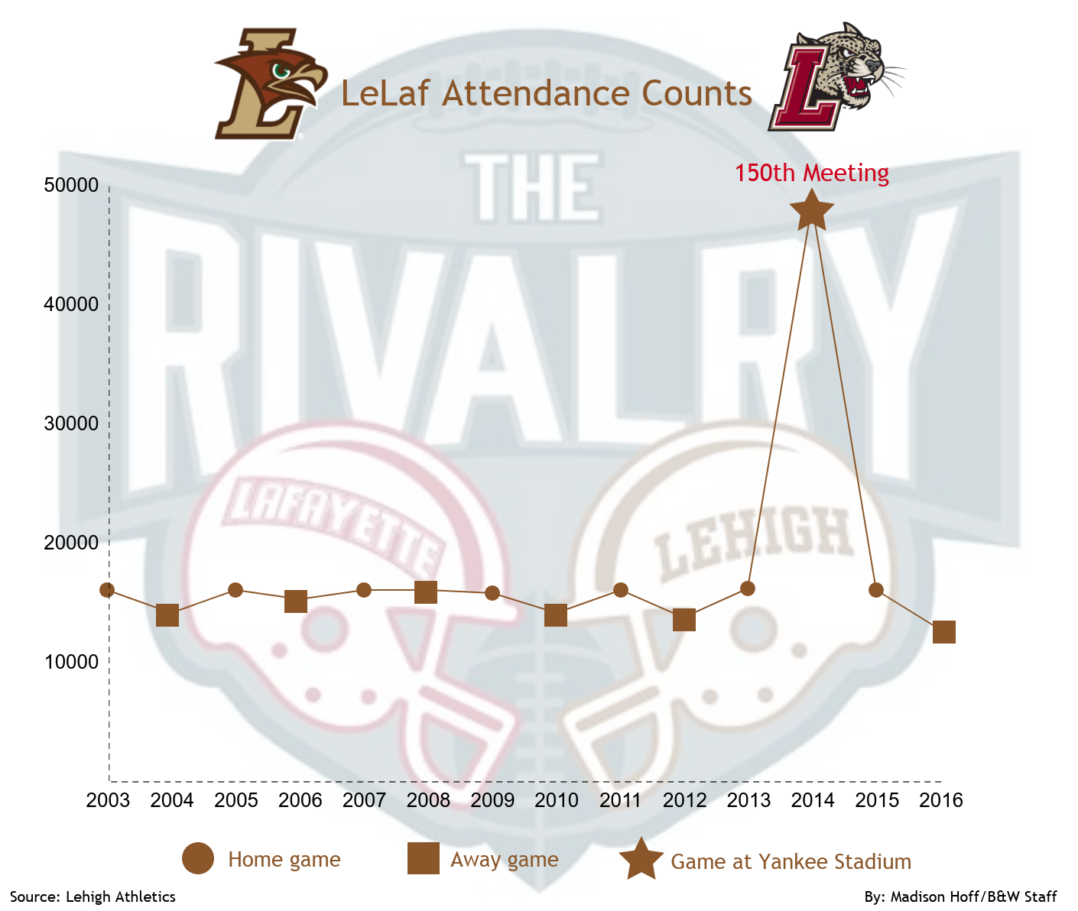The 153rd meeting of Lehigh-Lafayette football is completely sold out.

Lehigh sold out last week, while Lafayette sold their remaining tickets by Wednesday night. However, “selling out” looks different for each school.
“The home team gets more and it is based off the size of the school,” said Richard Haas, Lehigh’s assistant athletic director for sales and marketing.
Haas said about 10 years ago, Lehigh and Lafayette devised a ticket sale model based on historical data, size of student body, size of alumni and stadium size. So for The Rivalry game at Goodman Stadium, which seats 14,400 people, Lehigh gets about 10,000 tickets while Lafayette gets a little over 4,000. For a game at the smaller Fisher Stadium, which seats 13,130, Lafayette gets about 7,500 tickets and Lehigh gets about 5,500.
However, Renne Ricciuti, Lafayette ticket manager, said Lehigh sometimes sells seats for the grassy hill and standing room, which Lafayette does not have. This allows Lehigh to sell about 16,000 tickets, over the hard seating capacity.
Haas said the ratio of tickets allotted depends on the venue of the game because of the different stadium sizes and student population sizes.
Haas said student attendance is a priority because students can only attend the game for four years, but alumni can attend as alumni for the rest of their lives. The schools save a number of tickets just for students.
“We do hold those and protect them so they’re not sold to non-students,” Haas said.
This year, students will account for roughly 30 percent of the attendees at the game — Lehigh students will make up about 18 percent and Lafayette will make up about 12 percent. The other 70 percent will be composed alumni, parents and fans of The Rivalry.
“It’s The Rivalry so everyone wants to go and be a part of it in some way or another,” said Bridget Walsh, a 2016 Lafayette graduate.
Walsh has attended every Le-Laf football game since her freshman year in 2012.
“I think it’s really special,” Walsh said. “It was a big factor when I was looking at Lafayette because I really wanted a school with a lot of school spirit, but I still wanted the small school atmosphere. So I think having The Rivalry added to that.”
Like most college football games, The Rivalry game alternates each year between Lehigh and Lafayette’s campuses, and typically away games generate a smaller attendance from the home team.
Last year, the game was held at Lafayette’s Fisher Stadium.
“I started getting on to the bus for the Lafayette game, and I figured maybe this won’t be worth it,” Fletcher said. “It’s a long drive and all that, but then once we got there, it actually turned out to be a lot of fun to be able to support the team and be out there with everyone.”
Haas said although there was a lot of talk last year that many Lehigh students wouldn’t attend the game because of concern about rules and regulations at Lafayette, the majority of students who bought tickets did appear to attend the game.
“We got to the game and looked in the stands and our entire student section was jammed shoulder to shoulder, there was no more room,” Haas said. “You couldn’t find an empty section of seats in the student section. There was concern, but it didn’t seem to play out that way.”
Phillip LaBella, the sports information director for Lafayette football, said Lafayette has no trouble convincing students to attend the game. He said students naturally want to attend the game because they’ve heard so much about it, even before they arrive on campus.
Like Lehigh, the college sells optional bus passes to away Rivalry games to provide students with transportation.
Most years between 12,000 and 16,00 tickets are sold for The Rivalry game between the two schools.
In 2014, the Le-Laf game sold 48,256 tickets.
That year was the 150th meeting of Le-Laf football. To celebrate the sesquicentennial anniversary of The Rivalry, the game was played in Yankee Stadium, a venue that seats more than 50,000.
“Within the Lehigh stadium you don’t really get the alumni coming in,” David Fletcher, ’17, said. “They mostly just stay outside and don’t really buy tickets for the game, but with everyone in there, like people that were probably 80 years old, like there were grandpas walking around and that kind of stuff. It was just really cool to see both sides, Lafayette and Lehigh, in one space altogether, having a good time.”
To prepare for that game, both Lafayette and Lehigh began selling tickets months in advance.
Haas said Lehigh wanted to make sure that every student could attend the game. The school sold to all current students and graduating students in the spring. Newly-accepted students, who had yet to even attend a class on Lehigh’s campus, were sold tickets in early summer.
“We actually went on sale and used it sell season tickets for the next year,” Haas said, “so we went on sale in early November of the current year, so we went on sale for rivalry 150 before rivalry 149 was even played.”
LaBella said the college did something similar. Lafayette staggered their ticket sales so students and alumni could buy at certain times and eventually sales were open to the general public.
Many alumni continue to come back to Rivalry football games. Haas said it is a tradition special to Lehigh, special to Lafayette and special to the history of college football.
Walsh said coming back to attend Rivalry games allows her to visit old friends and feel connected to the school once again.
“On weeks and weekends like this you kind of get to relive your glory days a bit,” Walsh said. “It’s just a special thing that only our schools have, and even when you talk to people about Lafayette and Lehigh, maybe some of them don’t know about it, but you always brag about The Rivalry.”





Comment policy
Comments posted to The Brown and White website are reviewed by a moderator before being approved. Incendiary speech or harassing language, including comments targeted at individuals, may be deemed unacceptable and not published. Spam and other soliciting will also be declined.
The Brown and White also reserves the right to not publish entirely anonymous comments.